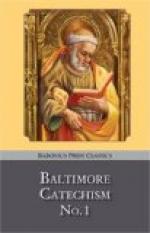After the Sorrowful Mysteries come the five Glorious Mysteries, and they are: (1) The Resurrection of Our Lord; (2) The Ascension of Our Lord; (3) The Coming of the Holy Ghost upon the Apostles; (4) The Assumption of the Blessed Virgin; and (5) The Coronation of the Blessed Virgin in Heaven. All but the last have been explained in foregoing parts of the Catechism. In this last Mystery we consider our Blessed Lady just after her entrance into Heaven, being received by her Divine Son, our Blessed Lord, and being crowned Queen of Heaven over all the angels and saints. In saying the Rosary we are, as I have told you before, to stop after mentioning the Mystery and think over the lesson it teaches, and thus excite ourselves to love and devotion before saying the “Our Father” and “Hail Marys” in honor of it. Generally what we call the beads is only one third of the Rosary; that is, we can only say five mysteries on the beads unless we go over them three times. If you say your beads every day you will say the whole Rosary twice a week and have one day to spare.
On Sundays, except the Sundays of Advent and Lent, we should say always the Glorious Mysteries. You see, the Mysteries run in the order in which they happen in Our Lord’s life. So on Monday we say the Joyful Mysteries, on Tuesday the Sorrowful, and on Wednesday the Glorious. Then we begin again on Thursday the Joyful, on Friday the Sorrowful, on Saturday the Glorious. In Advent we say the Joyful, and in Lent the Sorrowful Mysteries on every day. In Eastertime we always say the Glorious mysteries.
I have told you what the letters I.N.R.I. mean; now let me tell you what I.H.S. with a cross over them mean. You often see these letters on altars and on holy things. They are simply an abbreviation for Our Lord’s name, “Jesus,” as it was first written in Greek letters. Some also take these letters for the first letters of the Latin words that mean: Jesus, Saviour of men. And as the cross is placed over these letters it can signify that He saved them by His death on the Cross.




